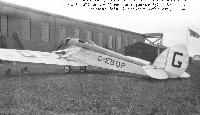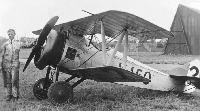Фотографии
-
Регистрационный номер: G-AETU Bearing the name of its builder, Premier Aircraft Constructions Ltd of Maylands aerodrome, romford, on its rudder, the first of three Gordon Dove single-seat ultralights, G-AETU, displays its neat lines. Designed by S.C. Buszard and powered by a 750 c.c. Douglas Sprite engine, the Dove had a fixed, spatted main undercarriage and bracing struts from the fin to the tailplane. This aircraft first flew on March 3, 1937, and its Authorisation to Fly was issued the following day. Used by the Romford Flying Club, ’ETU survived until February 6, 1940, when it was burned in a hangar fire at Maylands. In addition to the other two Doves completed, another five were allocated registrations but were not built.
Самолёты на фотографии: Gordon Dove - Великобритания - 1937
-
Регистрационный номер: G-ACCM The AVRO 631 Cadet was a scaled-down version of the Tutor intended for use by civilian flying clubs or private owners, with wooden wings and control surfaces and a 135 h.p. Armstrong Siddeley Genet Major I engine. This example, G-ACCM, was delivered to Air Service Training Ltd (AST) at hamble, the largest user of the type, in March 1933, but suffered a night crash in the River Thames at Purfleet, Essex, on April 17, 1936. It was apparently later bought by the Far East Aviation School at Hong Kong, an AST associate. Although AST found the Cadet ideal for ab initio instruction, aerobatics and blind flying, it did not fare well on the civil market because it was expensive to run compared with contemporary light two-seaters and its wings could not be folded.
Самолёты на фотографии: Avro Cadet / Type 631/643 - Великобритания - 1932
-
Регистрационный номер: K-104, G-EAAQ The Avro 536 was created by increasing the width of the Avro 504K’s fuselage by 9in so that four passengers could be squeezed into the rear cockpit. This example, K104/G-EAAQ, registered to A.V.Roe & Co Ltd at Hounslow Heath, suffered engine failure over Rotherhithe on September 9, 1919, while being flown from Hounslow to Southend by Capt E.A.Sullock, and the aircraft’s back was broken in the ensuing forced landing in Southwark Park in south-east London.
Самолёты на фотографии: Avro 536 / 546 - Великобритания - 1919
-
Регистрационный номер: G-AALH DESIGNED AS a compact single-seat light fighter with a fabric-covered all-metal airframe, Blackburn Lincock Mk II G-AALH was built at Brough and was awarded its C of A on February 28, 1930. It had a 255 h.p. Armstrong Siddeley geared Lynx IV radial engine. In 1930 it was evaluated by the Royal Canadian Air Force at Camp Borden, but although it was much liked by pilots the type was not adopted because it was not a first-line fighter and there was no need for a transitional aircraft from trainers to fighters. Along with the sole Lincock III, G-ABFK, it was used by Alan Cobham’s National Aviation Day Display organisation in 1933-34 for the “radio controlled” aerobatics act, powered by a 270 h.p. Lynx Major, but was dismantled in March 1935. It is probably seen here in the mauve colour scheme applied during the winter of 1933-34.
Самолёты на фотографии: Blackburn Lincock / F.2 - Великобритания - 1928
-
Регистрационный номер: G-EBQP, J7326 De Havilland D.H.53 Humming Bird G-EBQP began life as J7326, one of eight ordered for evaluation as primary trainers for the RAF, and was also earmarked for experimental launch and retrieval trials operating from the rigid airship R33. at that time it had a 32 h.p. Bristol Cherub engine. Subsequently it was one of several ex-RAF D.H.53s made airworthy by P.G.N. Peters and his fellow members of the Royal aircraft establishment aero Club at Farnborough. Granted its Certificate of Airworthiness (C of A) on May 13, 1927, in January 1928 its ownership passed to Fg Off A.F. Scroggs at Henlow. It ended its life in a crash at Hamble on July 21, 1934.
Самолёты на фотографии: De Havilland Humming Bird / D.H.53 - Великобритания - 1923
-
Регистрационный номер: K-150, G-EAFK At the end of the First World War many aircraft manufacturers had high hopes of launching successful civil aircraft to sustain their business, but the glut of cheap war-surplus machines thwarted their plans. One victim was the Grahame-White Aviation Company’s G.W.E.6 Bantam, a single-seat sporting biplane designed by M. Boudot and powered by an 80 h.p. le Rhone rotary engine. Three were built, the first being K150, seen here at Hendon in 1919, where it met its end when it crashed into a hangar on July 6 that year.
The Graham White Bantam (K150) was an experimental light plane designed by M. E. Bondot and built in 1919. Powered by an 80-h.p Le Rhone rotary, the Bantam had a maximum speed of 102 m.p.h. for an a.u.w. of 995 lb. Stall 40 m.p.h., duration 2 hrs. and empty weight 640 lb. Span 20 ft., length 16 ft. 6 in., and wing area 130 sq. ft.Самолёты на фотографии: Grahame-White Bantam - Великобритания - 1919
-
Регистрационный номер: G-EBEW Taxiplane G-EBEW was the first of its type, intended as an economical three-seat general utility aeroplane using the Bristol Aeroplane Co’s 100 h.p. Lucifer three-cylinder radial engine. However, when it was tested at the Aeroplane & Armament Experimental Establishment at Martlesham Heath in April 1923 it proved to be overweight with two passengers in the rear cockpit, and therefore could only be certificated as a two-seater. Consequently only two more were built. This machine was scrapped in July 1925.
Самолёты на фотографии: Bristol Taxiplane / Primary Trainer - Великобритания - 1923
-
Регистрационный номер: G-AAID THE CAPTION to this picture showing the sole ABC Robin, G-AAID, at Heston on July 3, 1929, states that the aircraft was “made in secret at Walton-on-Thames” in Surrey. A single-seat high-wing cabin monoplane with folding wings and a plywood fuselage, it was designed by A.A. Fletcher and built by ABC Motors Ltd, who fitted it with the company’s new 40 h.p. Scorpion two-cylinder horizontally opposed aircooled engine. After its maiden flight at Brooklands in June 1929 it was shown at the Olympia Aero Show the following month. The picture shows how the windscreen had to be raised to allow access to the fuel tank filler caps; in November 1929 the windscreen was moved back so that the caps were outside the cockpit, the fin and rudder were enlarged and the fuselage lines modified. A C of A was issued on June 27, 1930, and G-AAID survived until 1932, when it was scrapped at Brooklands.
Самолёты на фотографии: ABC Robin - Великобритания - 1929
-
Регистрационный номер: G-ABNT CIVILIAN AIRCRAFT Co Ltd Coupe II G-ABNT was built at Hedon, Yorkshire, in 1931, and Flt Lt Bowling flew it to tenth place in the Heston-Cardiff race on september 19 that year, averaging 89 m.p.h. on its 100 h.p. Armstrong siddeley Genet Major I engine. After being acquired by S.B. Cliff early in 1933 it was based first at Woodley and then at Whitchurch. Later that year it was acquired by Mr G.O. Rees of Cardiff, who flew it from the sands along the south wales coast. In 1939 it was dismantled at Carmarthen, and survived to be sold in 1978 to Shipping & Airlines Ltd, which restored this unique survivor to airworthy condition. “Bunty”, as it is affectionately known, is now based at Biggin Hill.
Самолёты на фотографии: Civilian (CAC) Coupe - Великобритания - 1929
Статьи
- -
- American Classics
- Off the Beaten Track...
- ??? - Surprise, surprise!
- D.Moore - Ryan and the triangular pterodactyls
- D.O'Connor - Flying the Furrow
- G.Warner - To Belfast via Calcutta
- G.Warner - Why was the "Bristol" Mercury so long lived?
- J.Forsgren - Northern exposure
- J.Pote - From Penthouse to Workhorse
- M.Oakey - Out of the blue
- M.O'Leary - The tragedy of Flight Three
- N.Stroud - Hef and the Big Bunny
- N.Stroud - Messerschpitts at five o'clock!
- P.Brooks - One furious summer
- P.Jarrett - Under the windstocking








